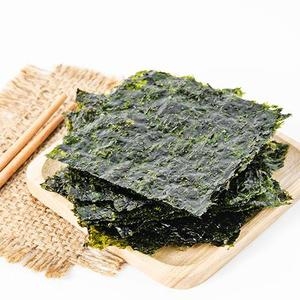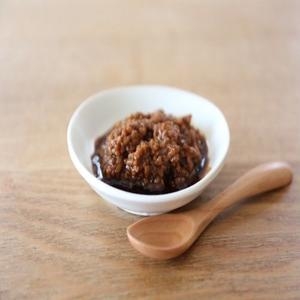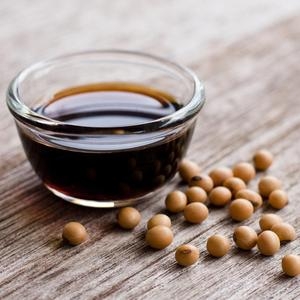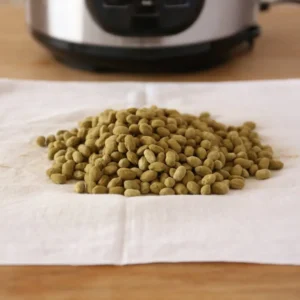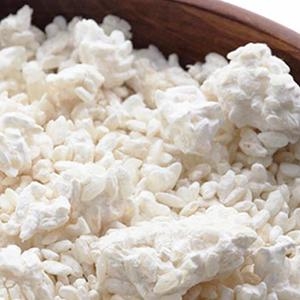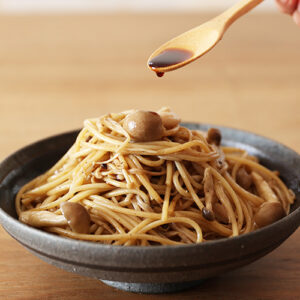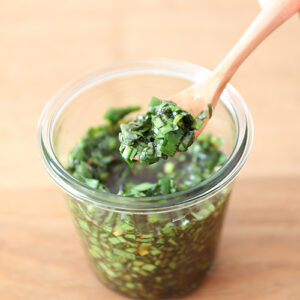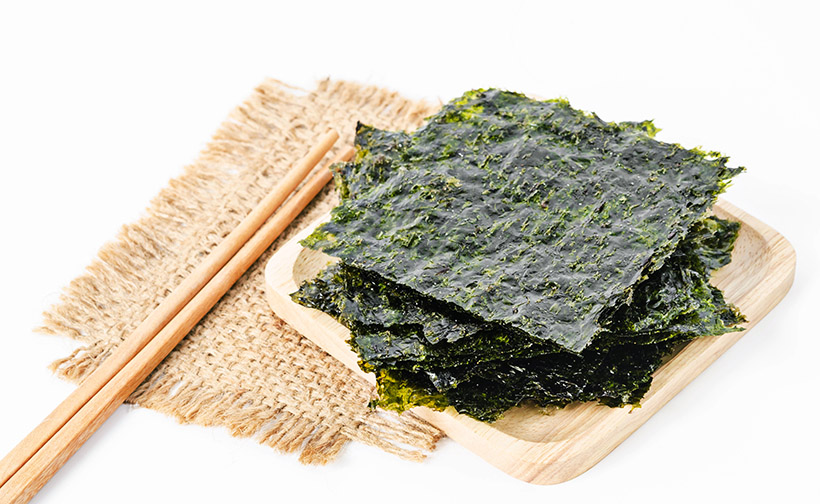
Nori, the delicious dark-green sheets of edible seaweed that often wrapped around your sushi. Nori has rich natural umami flavor from the seaweed, even without adding additives from the manufacturing process. This time we will tell you many things about nori, how nutritious it is, and nori recipes that you must try!
What is Nori?
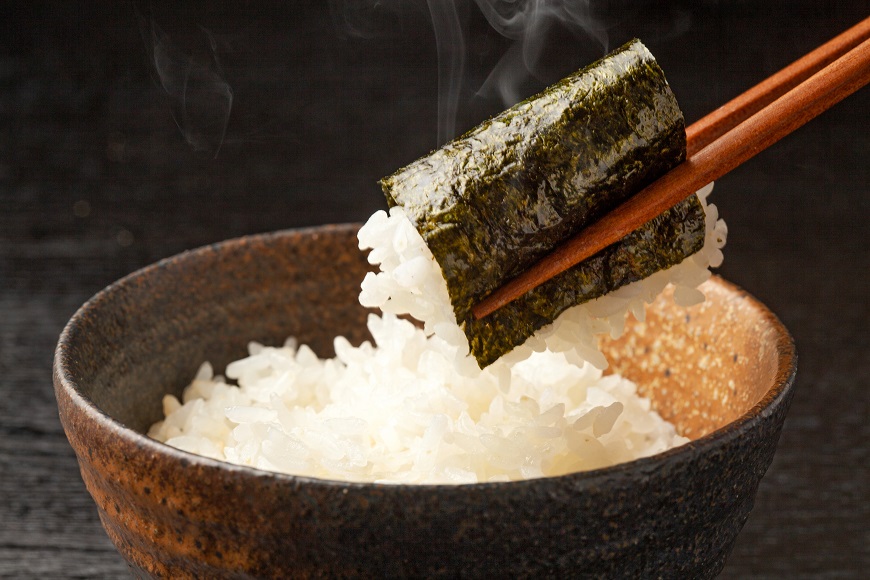
Nori is a traditional Japanese food used in various dishes, including rice balls, sushi, and even noodles such as ramen.
Nori (written as 海苔 or just のり in Japanese) is dried and pressed sheets of edible seaweed. It is also often translated in English as “laver”.
Nori took form of green or dark green thin sheets of seaweed, and it is made from species of Porphyra/Pyropia especially Pyropia tenera and Pyropia yezoensis (many species of Porphyra have recently been reclassified as Pyropia).
The seaweed made for nori can naturally grow on sea rocks and attached to other seaweeds. But it can be commercially grown on nets that are seeded onshore in tanks and are taken out to sea when they are ready. Then, if the seaweed has grown to about 15 cm, it finally can be harvested. The harvest time varies depending on the production area, but it is held from late October to May of the following year.

After the seaweed is harvested, then it’s washed with fresh water and put into a machine to be shredded into smaller size. Then the seaweed is poured into a machine that will press the seaweed (similar to papermaking machine) which allows it to drain. Then it is dried into form of paper-like sheets over a heated surface.
You can find nori in several forms. There are the nori sheets in big and small size, shredded nori, seasoned nori, and nori furikake. You can eat seasoned nori as a snack!
In Japanese foods, nori is used in various dishes. The most common is for wrapping onigiri/rice balls and sushi. But there are many other ways to use nori which we will tell you in later section!
What Does Nori Taste Like?
Although nori’s flavor is depended on its quality, but in general it will have umami flavor with a hint of salt and sweetness. The texture range from crispy to a little bit chewy.
“Umami” flavor has become the a worldwide language. Well-known components that make umami flavor include inosinic acid contained in dried bonito/katsuobushi, guanylic acid contained in shiitake mushrooms, and glutamic acid contained in kelp/konbu.
These umami components are found in various foods such as cheese and tomatoes. Among them, nori has all of inosinic acid, guanylic acid, and glutamic acid. Therefore, the umami flavor in nori is great. Many sources said that there is no other natural food like nori.
To experience the best umami flavor and crispy texture of nori, make sure you choose the good quality nori!
Recommended High-Quality Nori
Homemade Nori Sushi Rolls Recipe
After you know about what is nori and how nori tastes like, now we want to tell you about how to use nori.
One famous dish to make with nori is sushi rolls. For you who are familiar with Japanese foods, if you think about sushi, you’ll immediately think about nori, and vice versa.
So here we will tell you about how to make sushi rolls with nori at home, and then in the next section we will tell you about other dish that can be combined with nori.
It’s very easy to make sushi rolls at home! You can choose any filling that you like, such as crab stick, egg, cucumber, etc.
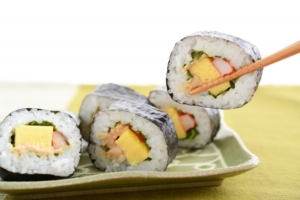
Easy Nori Sushi Rolls Recipe
Ingredients
- 450 grams Rice cooked
- 3 sheets
Nori or Grilled Nori - 75 ml Sushi Vinegar 5 tbsp
- 6 pieces Tuna strip or crab stick 2 pieces for each roll
- 3 slices Tamagoyaki 1 slice for each roll
- Cucumber Appropriate amount
Instructions
- Pour sushi vinegar on freshly cooked rice, and mix them by doing 'slicing' movement with rice paddle.
- Spread a bamboo rolling mat or cooking sheet, place the nori vertically with the shiny side down on it. Then spread vinegared rice evenly. Leave about 3cm strip of the nori sheet uncovered on the top.
- Place the fillings (strips of tuna strip/crab stick, tamagoyaki, and cucumber) in a line until near edge of the nori sheet so that they sticks out from the edge. Make sure not to overfill the nori.
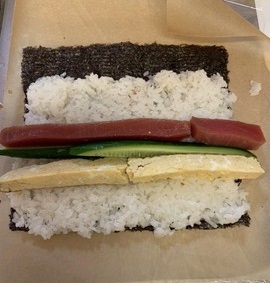
- Hold the ingredients with your index finger and forefinger in both hands, tuck your thumbs underneath the bamboo mat/cooking sheet, then roll the bamboo mat and the nori sheet forward with slight pressure. Roll slowly so that the sushi is rolled evenly, and make sure that the fillings are fully covered with the rice and the nori sheet.
- Wet the 3cm uncovered part of the nori sheet by wetting your fingers with cool water. Complete the rolling up of nori sheet with the bamboo mat/cooking sheet by bringing the uncovered part of the nori at the top to stick with the the back of the nori.
- Place the sushi roll on a cutting board and first cut it in half with a sharp knife. Then, put the sushi halves beside each other and cut them into small slices. To cut the sushi roll smoothly, put the knife under cold water before and after cutting.
- After you cut it, arrange sushi on a plate and serve it with soy sauce. You can also add wasabi and pickled ginger if you want. Then, your sushi rolls is ready to eat!
Notes
Other Ways to Use Nori
Other than sushi rolls, there are many dishes that you can eat or make with nori.
Before eating, it is recommended to add a little heat to the nori. It will soften and the aroma will be enhanced.
Slowly add heat (using a small lighter or low heat from the stove) on the back side of nori, the one with the slightly coarse surface, from far away then closely until the nori turns dark green evenly.
Eat with White Rice
You can always eat nori with rice. There is this famous Japanese food called onigiri which is a rice balls with various fillings wrapped in nori.
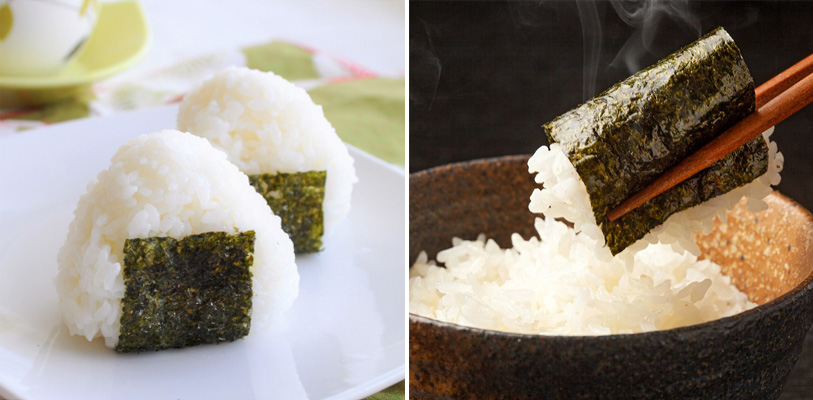
Enjoy Nori with A Meal Set
You can enjoy nori with a Japanese or regular meal set. Nori is suitable for breakfast, lunch, and dinner.
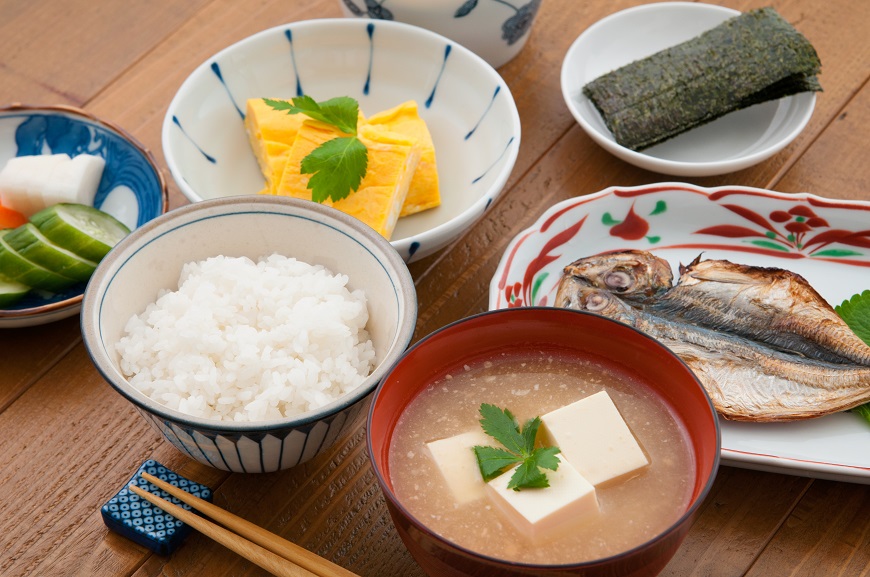
Add Nori to Your Lunch Box

Adding nori to your lunch box is a good way to enjoy your lunch! You can try Japanese-style lunch box or bento like in the article below!
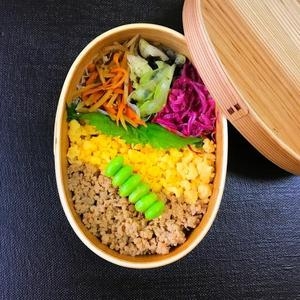
As a Topping for Salad
Cut nori into small pieces or use shredded nori and put it on your favorite salad!
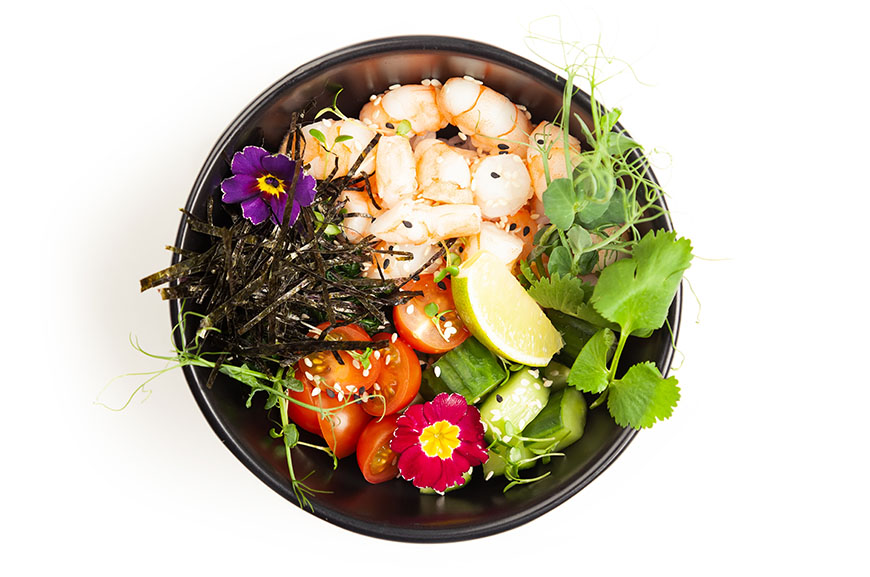
As a Topping for Ramen and Noodles
Put sheets of nori as it is, cut nori into small pieces, or use shredded nori then put it on your ramen, udon, or your other favorite noodles!
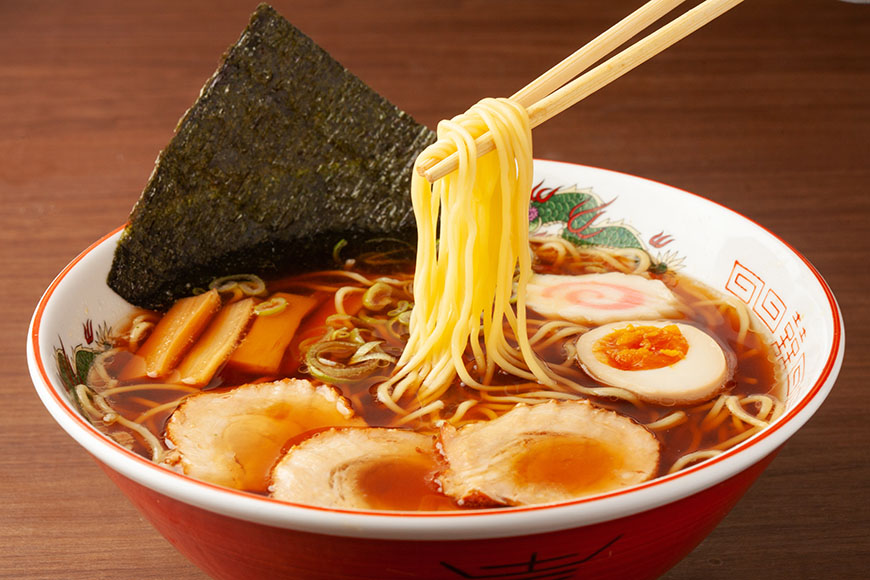
For Teriyaki and Fried Food Accents
You can eat nori together with teriyaki or other fried foods. It will be more delicious!
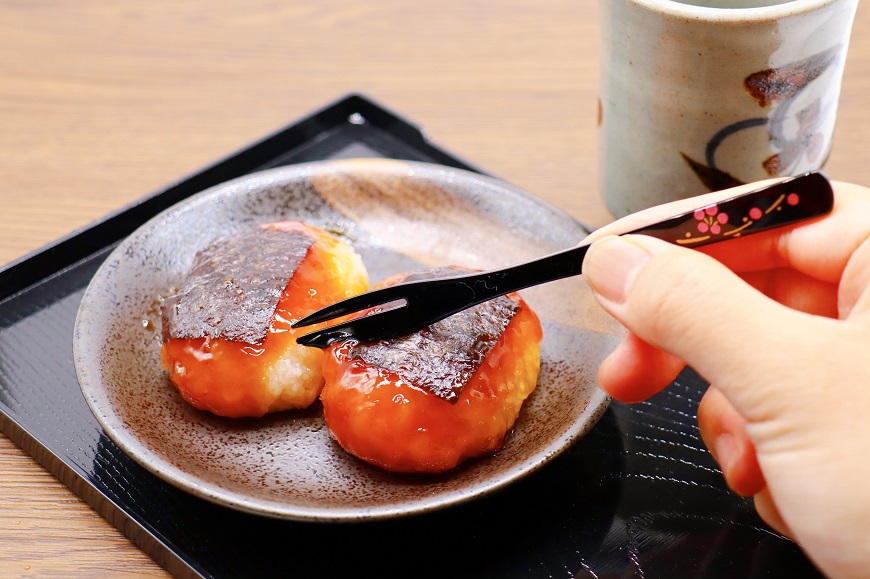
Eat Nori as a Snack
You can eat nori just as it is as a snack. With its low calories and many nutrients, nori will be a delicious healthy snack.
You can eat any nori for snack, but it will be more tasty if you choose the seasoned one with small size.

Delicious Nori Recipes
Knowing how “umami” the nori taste, you must want to make dishes with nori. Thus, we want to tell you nori recipes that you have to try before we tell you about how nori has many health benefits! Here are some easy recipes with nori that you can make at home.
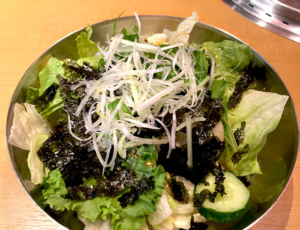
Crispy Vegetable Salad with Nori and Karaage (Fried Chicken)
Ingredients
- ½ head Sunny (Romaine) Lettuce
- ½ Cucumber
- 1 Sheet Spring roll skin
- 2 Sheets Nori, Shredded
- 4 pieces Karaage or Fried Chicken
- Frying oil on appropriate amount
- Your favorite dressing on appropriate amount
Instructions
- Wash the lettuce and drain it well. Cut the cucumber in half vertically and then cut it diagonally.
- Cut the spring rolls skin into 3 equal parts with a kitchen scissors and cut into pieces about 5 mm wide. Separate them one by one before frying.
- Fry the spring rolls at 170 degrees Celcius. The color will change in a few seconds, so scoop it up all at once with frying strainer.
- Prepare the karaage or fried chicken. You can fried the frozen one or buy the already fried one. The crispy type of karaage goes well with salads.
- Cut the karaage into pieces about 2 cm in size. As a guide, use 3 to 4 pieces of large karaage and 5 to 6 pieces of small karaage.
- Place the lettuce and chopped cucumber on a plate. Then put the chopped karaage and fried spring rolls skin.
- Finally, add plenty of shredded Nori. Pour your favorite salad dressing and it is ready to serve!
Tips
- Sunny lettuce and frilled lettuce with soft leaves go well with the crispy texture of fried chicken and spring rolls skin. It's a salad with fried food toppings, so dressing with low oil is recommended.
Notes
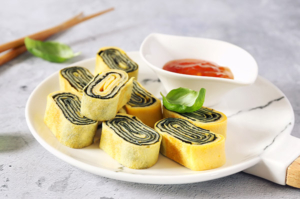
Tamagoyaki with Grilled Nori
Ingredients
- 3 eggs
- 1 Sheet Grilled Nori
- 1 teaspoon Tamari soy sauce (whole soybean sauce that does not use wheat)
- ½ teaspoon Canola oil or other frying oil
Instructions
- Cut nori to the size of the frying pan.
- Put soy sauce on a bowl, break the eggs into it, then mix them.
- Heat the frying pan and pour the cooking oil on it.
- Pour a little over half of the mixed egg into the oil-heated frying pan, heat on medium to high medium heat, and put half of the grilled nori on it.
- When the eggs start to harden, roll it along with the nori from the top side of the frying pan to the bottom side.
- Move the rolled egg (from the previous step) from the bottom side of frying pan to the top side, then pour the remaining egg liquid. Lightly lift the rolled egg with chopsticks and add the egg liquid onto the frying pan.
- Place the remaining grilled nori on the egg. When the eggs start to harden, roll it again with the same technique as before.
- Pick the tamagoyaki from the frying pan, cut into 4 equal parts and serve.Your delicious tamagoyaki with nori is ready to eat!
Notes
Nori Nutrients
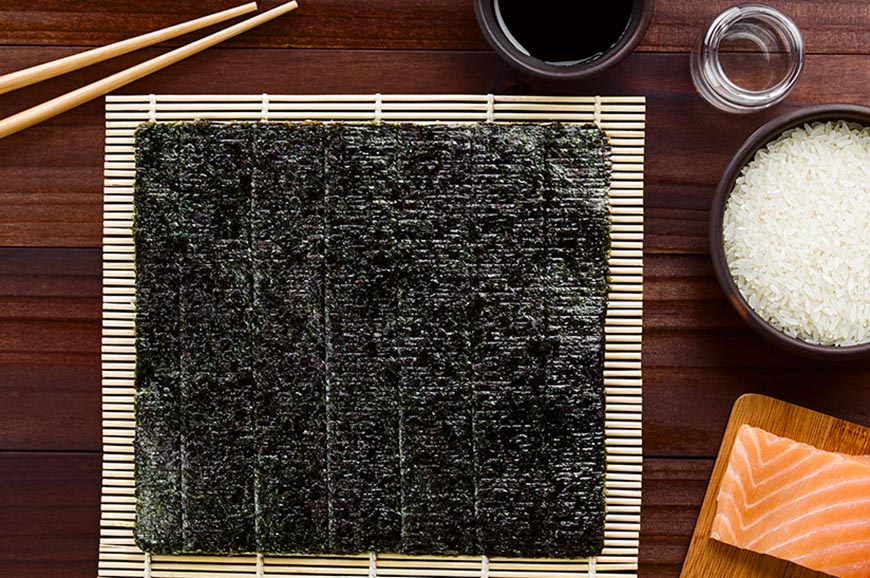
Nori contains vitamins, minerals, and dietary fiber that are good for health but people tend to lack. Here are the nutrients that nori has!
Vitamins
One sheet* of nori contains 1.5 times as much vitamin C as one Japanese orange.
Moreover, the molecules of vitamin C is generally easy to break when heated, but the vitamin C contained in nori has the characteristic of being resistant to heat. Nori also contains vitamin A, B1, and B2. Eating 2 sheets of nori a day will suffice your daily needs of vitamin A, B1, and B2.
* Note: General size of one sheet of nori is 19cm x 21cm and about 3g in weight. In Japanese it’s called 1帖 (ichi-jo).
Dietary Fiber
About 30% of nori is dietary fiber. Currently, average dietary fiber intakes among adults in the United States is about 15 grams a day, which is less than the required amount of 25 to 30 grams of dietary fiber a day from food*. But if you eat nori, you can easily get the dietary fiber that your body needs. One piece of nori has dietary fiber equivalent to one banana, one tomato, one quarter lettuce, and one Chinese cabbage.
* Source: UCSF Health. Increasing Fiber Intake.
Iron
Iron is important for preventing anemia, but many people don’t like to eat animal’s liver and spinach (which there are a lot of iron in these foods). Five pieces of nori contain the same amount of iron as in 40g of beef liver and 1 pack (approx. 200g) of boiled spinach. Moreover, nori also contains protein and vitamin C, which are said to be highly efficient when taken together.
High Quality Protein
Nori contains a lot of protein as 40% of nori is made of protein and this is comparable to soybean. This means protein of nori is excellent in terms of quantity and quality. But considering the balance of amino acids contained in the protein, eating nori together with soybeans will make up for the shortage of protein’s amino acids that you need.
Nori Nutritions Fact
Here are nutritions contained in nori per 100g of Serving*
| Energy | 188kcal | Vitamin D | 0µg |
|---|---|---|---|
| Protein | 39.4g | Vitamin E α-tocopherol | 4.3mg |
| Lipid | 3.7g | Vitamin B1 | 1.21mg |
| Carbohydrate | 38.7g | Vitamin B2 | 2.68mg |
| Calcium | 140mg | Vitamin C | 160mg |
| Phosphorus | 690mg | Cholesterol | 21mg |
| Iron | 10.7mg | Dietary fiber | 31.2g |
| Zinc | 3.7mg | Salt equivalent | 1.5g |
| Vitamin A retinol equivalent | 3,600µg |
* Note: this is an approximate count of nutrients of nori in general. The nutrients contained in nori depends on various factors such as the quality of nori, planting, harvesting, production process, etc. Please refer to the nutritional information on your nori’s package.
Is Nori Good for You?
As we explained above, nori has nutritions that your body needs. But what’s good about all of those? Is nori really good for you?
The answer is: of course!
There is even a verse going around in Japanese for Nori “一日二枚で医者いらず” which means “two sheets a day to keep the doctor away”. It’s sure sound familiar to the apple. Eating two sheets of seaweed a day can provide some nutrients to meet your daily needs!
Here we will tell you health benefits of nori!
#1 Low Calorie, High Fiber, Perfect for Your Diet Plan

Even if you eat one sheet of nori (1帖) it has only 6kcal. Which means nori is very low in carbohydrates and calories! It is a perfect snack for you who are concerned about calories.
In addition, about one-third (30%) of nori is made of dietary fiber. The dietary fiber of nori is softer than the dietary fiber contained in vegetables, and it gives a gentle intestinal regulation without damaging the stomach wall or intestinal wall. It is also said to be useful for vitamin synthesis in the intestine by the good bacterium.
#2 Nori Can Make Your Skin Beautiful

Vitamin C is known for its skin whitening effect because it has the effect of suppressing the production of melanin to prevent skin blemishes and the double whitening effect of thinning the blemishes that have been created on skin.
But it is generally said that vitamin C is sensitive to heat and its components are destroyed when cooked. However, vitamin C contained in nori is strong to heat, and its nutrients are not destroyed even when cooked. Thus, the vitamin C in nori will be effective to our body.
Also the amount of vitamin C in nori is large, that one sheet (1帖) of grilled nori contains 1.5 times as much vitamin C as Japanese oranges!
It also contains a lot of vitamin A and β-carotene, which make the skin and mucous membranes strong and beautiful, so you can get more than one egg’s worth of vitamin A in one take.
#3 Fatigue Recovery Effects of Vitamins B1 and B2 in Nori

Approximately 3 pieces of nori contain vitamins B1 and B2 equivalent to pork shoulder loin (about 1 piece of thinly sliced meat/30g). This is equivalent to the amount of vitamins B1 and B2 that an adult woman needs in a day.
Vitamins B1 and B2 efficiently converts sugar into energy, so if you eat it when you have no appetite or are easily tired, these vitamins will help you to recover from fatigue.
Since rice’s component is also sugar, it is Japanese common knowledge to wrap nori around rice balls (onigiri).
#4 Taurine and Protein in Nori to Strengthen Liver Function

Nori is rich in taurine. Taurine is said to be effective in reducing bad cholesterol, arteriosclerosis associated with high blood pressure, angiopathy, brain diseases such as cerebral thrombosis, myocardial infarction, and heart failure. It is also said to be effective against hangovers, chronic hepatitis, cataracts, and diabetes. Nori also rich in protein. Protein in two pieces of nori is equivalent to about protein in 15g of boiled soybeans.
Did you know that when you drink alcohol, the liver decomposes alcohol? The liver consumes protein when doing this, so it’s important to eat protein-supplementing foods when drinking alcohol.
Combining taurine, which has an effect of strengthening liver, with protein in nori, the liver function can be enhanced. This is a really nice effect for you who drink alcohol (but still, drink your alcohol mindfully!).
#5 EPA (Eicosapentaenoic Acid) in Nori for Cancer Prevention

Nori contains EPA (Eicosapentaenoic Acid) which is one of the nutrients that are currently attracting attention for being effective in preventing cancer.
EPA is said to have the effect of reducing bad cholesterol and triglyceride, which is the cause of obesity. This happens because EPA has the function of lowering β-carotene and cholesterol levels. So it’s really good for preventing lifestyle-related diseases.
It is said that EPA is also good for cognitive function and blood vessels. EPA plays an important role for maintainin your health.
Unfortunately, there are nori products that have many additives in it. Too many additives will deteriorate the quality of nori, thus snatch away its initial health benefits.
To take nori’s health benefits to its fullest for a healthy diet, make sure you’re choosing the high-quality nori without additives!
Source:
Health Benefits of Nori 1 (Japanese)
Health Benefits of Nori 2 (Japanese)
How to Store Nori
Handling Method
Moisture is the enemy of nori. Nori is very sensitive to light, temperature, and humidity.
When placed in a place with high temperature and humidity, nori will gets damp, deteriorates, and turns red. It will lose its crispy texture, flavor, and aroma, and becoming a so-called “cold nori”.
If you handle and store it properly, you can enjoy it until the end without spoiling the flavor as much as possible.
It is important to take out just the amount you need to use from the container/bag, then seal it again immediately. Place the nori in a cool and dry place so as not to absorb moisture as much as possible. You can enjoy delicious nori at any time!
Storage Method
When storing the opened nori:
• Recommended: If stored in refrigerator, it will last for 1-2 months. However, if you take the nori in and out frequently and expose it to the air many times, the flavor will be lost faster.
• If stored in the freezer, it will last for about 10 months.
• If stored in room temperature, depending on the humidity, the nori will lasts about 2-3 weeks. When storing in room temperature, please keep in a cool place and away from direct sunlight.
Freezer is recommended for long-term storage of nori as it will has a longer-lasting preservation of the texture and flavor than when you store it in refrigerator. However, it’s easier to use if it you store it in the refrigerator as you don’t need to unfroze the nori.
When storing in the refrigerator, store the nori with the desiccant in it. The desiccant can keep it more drier to avoid the deterioration of its quality.
When you store the nori in freezer, do not use desiccant. This is because desiccants lose their ability to absorb moisture in a month or two, so they are not very suitable for freezing, which is premised for long-term storage. Of course, there is no problem if you change the desiccant regularly, but it is quite a hurdle to remember to change it.
When storing the unopened nori:
Best to store the unopened nori in the freezer until the expiration date written on the package.
If you want to store the nori before you open the package, store it in the freezer. When opening the package, be sure to unfroze it to room temperature before opening it. Once opened, store in the refrigerator as described above.
By the way, the expiration date on the package of the nori is valid before opening. Please consume as soon as possible after opening.
Tips for Storing Nori
To make nori sheets that are no longer crispy to be crispy again, pass it lightly over a heat source (such as pass it on a stove without touching the fire/surface) a couple of times on each side.
Be careful to not get the nori too close and too long to the heat source as it will crinkle up fast and even catch on fire.
Where to Find High-Quality Nori
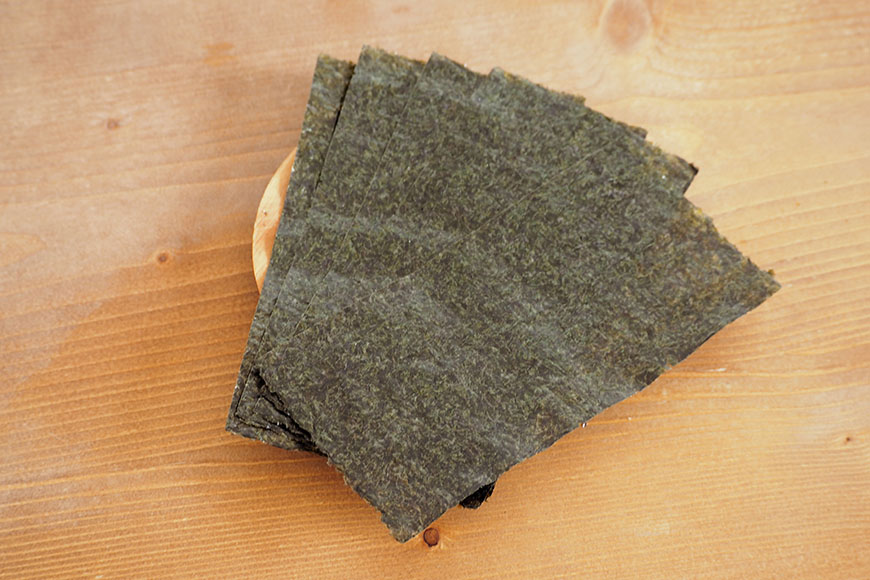
High-Quality Nori Characteristics
• Appearance: no holes, have shiny sheen surface, and same thickness across the surface.
• Taste: umami flavor with no strange or fishy smell. Not containing any strange flavors that mixes from other kinds of seaweed.
• Texture: crispy at first then melt with softness in your mouth.
Meanwhile, the appearance of low quality nori will has the color of lighter green or too brown or reddish. When you look at it over the light direction, it will have many uneven thickness dan needle holes. Low quality nori is often tasteless or sometimes mixed with strange flavors, often due to mixing with other seaweed. It is often too dry and easy to break when rolling for sushi. The texture is also chewy or hard to bite.
Where to Buy High-Quality Nori
When you buy nori, keep in mind to get it from a good source and safe to eat. You can buy high quality nori in stores that sell Asian foods and ingredients in your area or buy it online.
Also, it is said that 95% of nori or dried seaweed in Japan has undergone an acid treatment process to remove pathogens that inhibit growth, but this puts a burden on the natural environment and reduces fish catches. So, if you love the earth, choose the nori manufacturers that use eco-friendly way to produce their nori.
One of the brand that have high quality nori with eco-friendly producing system so the nori does not undergo acid treatment as much as possible (except in emergencies such as the spread of illness) is here!
Nori FAQ
- What is Nori and how does it taste?
-
Nori is dried and pressed sheets of edible seaweed. It is also often translated in English as “laver”. Nori took form of green or dark green thin sheets of seaweed, and it is made from seaweed species of Porphyra/Pyropia especially Pyropia tenera and Pyropia yezoensis.
Nori in general has umami flavor with a hint of salt and sweetness. The texture range from crispy to a little bit chewy. Nori has all of the components that make umami flavor, which are inosinic acid, guanylic acid, and glutamic acid. Therefore, the umami flavor in nori is great. To experience the best umami flavor and crispy texture of nori, make sure you choose the good quality nori.
- Is Nori good for health?
-
Yes! Nori has a lot of good nutrients: vitamins, dietary fiber, iron, high quality protein, etc. Therefore, nori has many health benefits, such as it can help your diet plan, make your skin beautiful, recover your fatigue, strengthen your liver function, and prevent cancer!
- How can I choose the best nori?
-
The sheet of high quality nori will virtually has no hole, has shiny sheen surface, and same thickness across the surface. When tasted, the high quality nori will have umami flavor with no strange or fishy smell. It should not contain any strange flavors that mixes from other kinds of seaweed. The texture from a high quality nori should be crispy at first then melt with softness in your mouth.
Also, it is said that 95% of nori or dried seaweed in Japan has undergone an acid treatment process to remove pathogens that inhibit growth, but this puts a burden on the natural environment and reduces fish catches. So, if you love the earth, choose the nori manufacturers that use eco-friendly way to produce ther nori.
Check out some of our nori recommendations!
- How should I store my nori?
-
The most recommended method is to store it in the refrigerator. If stored in refrigerator, it will last for 1-2 months. However, if you take the nori in and out frequently and expose it to the air many times, the flavor will be lost faster.
If stored in the freezer, it will last for about 10 months.
If stored in room temperature, depending on the humidity, the nori will lasts about 2-3 weeks. When storing in room temperature, please keep in a cool place and away from direct sunlight.
- How to use nori? What dishes can I make with nori?
-
One famous dishes that use nori is sushi roll. You can find how to make it easily at home here! Also, there are other ways to use nori, such as to eat nori with a meal set or lunch box, as topping for salad or noodles, eat nori together with fried foods, or just eat nori as it is as a snack!
We also have easy recipes that you can try!

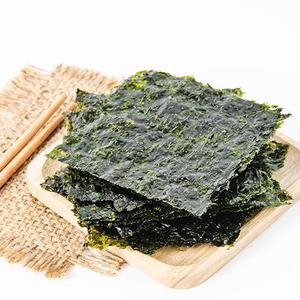
 Content List
Content List